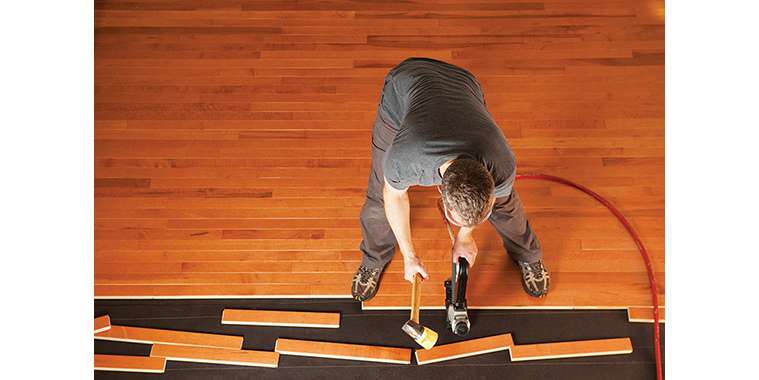For years, homeowners have preferred hardwood flooring. These floors are an investment because they’re timeless and durable. On top of that, you can choose from different colours, stains and grains to get the look you want.
Because hardwood floors are popular, they can help homes sell faster and increase your home’s value. Installing new wood flooring can recoup 118% of their cost, according to the National Association of REALTORS® 2022 Remodeling Impact Report. That made it one of the survey’s top two interior remodeling projects for cost recovery, behind hardwood floor refinishing.
Another benefit of wood flooring is you don’t need to replace it, unlike carpet or tile flooring. Instead, you can simply resand or refurbish it, saving money over time.
Even though wood floors have so many benefits, they do have a few downsides. Wear and tear can dent and scratch them, and mold, detergents, water and termites can damage them.
Refinishing vs. new floor installation
A new hardwood floor has a lot of selling points, but it may not be in your budget. In that case, you can refinish your existing floors to make them look brand new without the high price tag.
If you’re unsure which way to go, have a professional look at your floors. With an objective opinion, you can more easily decide if refinishing is right for you. Of course, if you refinish your existing floors, you’ll spend less than you would on installation.
Considerations for choosing the right flooring
In choosing the type of hardwood you want, you’ll select from engineered or hardwood flooring, and prefinished or finished on-site. You can also pick from different wood types and plank widths.
• Engineered vs. solid hardwood flooring
Solid hardwood planks are single pieces of wood, while engineered hardwood combines multiple layers of hardwood. Interlocking options make installing engineered hardwood easier.
Another plus for engineered hardwood floors: They reduce moisture problems you’d usually find in standard hardwood flooring.
• Prefinished vs. Finished On-site
Prefinished hardwood floors are finished at a factory, and a coat of polyurethane tops each board. Site-finished hardwood is shipped to your home unfinished, and the process of sanding, staining, and sealing is done after the floor is installed.
Prefinished boards have more uniform colour and staining, and some come with anti-scratch coating. But with site-finished planks, you can test and select stains and finishes that work with your interior. Many flooring experts can provide on-site guidance to help you find the best match for your home.
Wood types — Grain and colour
Wood flooring comes in different styles and shades, including grains and light and dark colours.
• Grain The way the wood flooring is cut and sliced determines the grain. Your floor’s wood grain is like its own unique fingerprint. Because no two look alike, this feature adds character to your home. The three common types of wood grain are flat, straight and curly.
• Colour Wood flooring is available in a wide range of colours. Trending colours include beige and gray tones, natural-looking wood, and dark charcoal or black stains.
Look for wood colours that complement your home’s overall design and your lifestyle. Darker wood floors will show scuffs and scratches more easily, while wear and tear will be less visible on lighter floors. Keep in mind that applying stains on-site will alter the natural colours of the wood. Most floor teams will help you select stains that hit your goal hues.
• Plank width The plank width of your hardwood floors can make a world of difference in your finished floor design. Width of the plank can make a room look bigger or smaller. Width varies from 3” up to 12”.
Alternatives to hardwood flooring
Despite wood floor advantages, they aren’t in everyone’s budget. Here are some alternatives for a great look minus the hefty price tag.
• Bamboo Bamboo flooring is a budget-friendly option that comes from the bamboo plant. The bamboo is sliced, shredded and pressed with heat to form wood-like boards.
Pros: Bamboo floors resist pests and are durable, easy to maintain, sustainable, and environmentally friendly. They also cost much less per square foot than most solid hardwoods.
Cons: These floors react to moisture, so they’re not a good choice in a humid climate. They also may show scratches more easily, and the range of tones and finishes is more limited.
• Laminate Laminate flooring is made of multiple layers of products combined through lamination, and it resembles wood flooring.
Pros: These floors come in planks or tiles that snap together, making them easy for DIYers. They aren’t made from trees and are extremely durable (great for high-traffic areas). Maintenance is easy, too.
Cons: Once laminate floors start to lose their sparkle, they can’t be refinished, only replaced. And because laminate is made with plastic and sometimes formaldehyde, it isn’t environmentally friendly. People with chemical sensitivities should make sure that any laminates conform to health regulations.
Moisture may damage some laminate flooring, so it shouldn’t be used in bathrooms or laundry rooms.
Questions to ask your flooring contractor
When it comes to your home, you want information. Here are some critical questions to ask your flooring contractor so that you’re well informed before and during the installation process.
• Are you licensed and insured to install and/or finish hardwood floors?
• Can you provide references, pictures and online reviews to support the quality of your work?
• What’s included in your flooring warranty?
• Is my subfloor suited to this installation?
• What’s the best hardwood flooring for my home?
• How long will it take to install my floor?
• What could happen to increase the costs?
• How will you contain the dust and do cleanup?
You can also contact a REALTOR® to get references to area contractors who have installed wood flooring. REALTORS® have information from satisfied homeowners and feedback from open house guests that will offer you a solid foundation to start from.
— Houselogic.com



